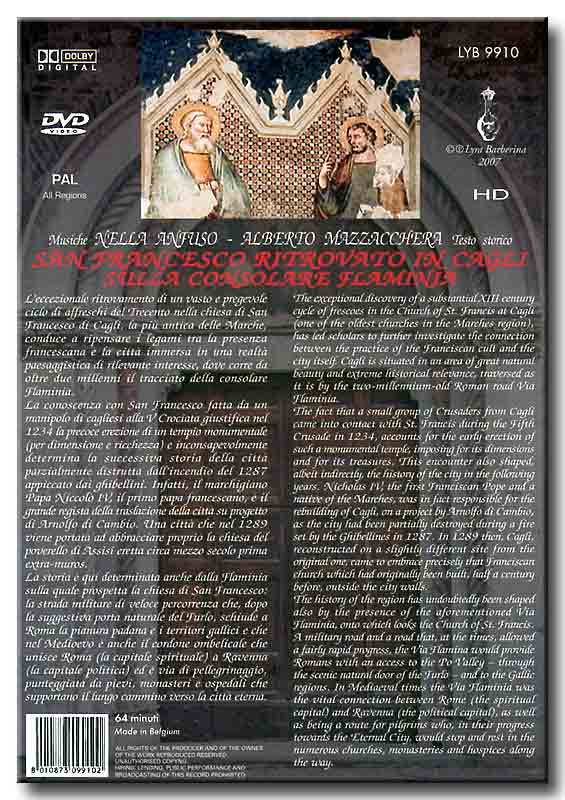|
|
|
|
|
|
DVD – EDIZIONE
PARIGINA – ALTA DEFINIZIONE
NELLA
ANFUSO
SAN FRANCESCO
RITROVATO
IN CAGLI
SULLA CONSOLARE
FLAMINIA
musiche e regia
NELLA ANFUSO
testo
ALBERTO MAZZACCHERA |
 |
 |
|
L’eccezionale ritrovamento di un
vasto e pregevole ciclo di affreschi del Trecento nella chiesa
di San Francesco di Cagli, la più antica delle Marche, conduce a
ripensare i legami tra la presenza francescana e la città
immersa in una realtà paesaggistica di rilevante interesse, dove
corre da oltre due millenni il tracciato della consolare
Flaminia.
La conoscenza con San Francesco
fatta da un manipolo di cagliesi alla V Crociata giustifica nel
1234 la precoce erezione di un tempio monumentale (per
dimensione e ricchezza) e inconsapevolmente determina la
successiva storia della città parzialmente distrutta
dall’incendio del 1287 appiccato dai ghibellini. Infatti, il
marchigiano Papa Niccolò IV, il primo papa francescano, è il
grande regista della traslazione della città su progetto di
Arnolfo di Cambio. Una città che nel 1289 viene portata ad
abbracciare proprio la chiesa del poverello di Assisi eretta
circa mezzo secolo prima extra-muros.
La storia
è qui determinata anche dalla Flaminia sulla quale prospetta la
chiesa di San Francesco: la strada militare di veloce
percorrenza che, dopo la suggestiva porta naturale del Furlo,
schiude a Roma la pianura padana e i territori gallici e che nel
Medioevo è anche il cordone ombelicale che unisce Roma (la
capitale spirituale) a Ravenna (la capitale politica) ed è via
di pellegrinaggio, punteggiata da pievi, monasteri e ospedali
che supportano il lungo cammino verso la città eterna. |
|
The exceptional
discovery of a substantial XIII century cycle of frescoes in the
Church of S. Francis at Cagli (one of the oldest churches in the
Marches region), has led scholars to further investigate the
connection between the practice of the Franciscan cult and the
city itself. Cagli is situated in a area of great natural beauty
and extreme historical relevance, traversed as it is by the
two-millennium-old Roman road Via Flaminia.
The fact that a small group of Crusaders from Cagli came into
contact with St. Francis during the Fifth Crusade in 1234,
accounts for the early erection of such a monumental temple,
imposing for its dimensions and for its treasures. This
encounter also shaped, albeit indirectly, the history of the
city in the following years. Nicholas IV, the first Franciscan
Pope and a native of the Marches, was in fact responsible for
the rebuilding of Cagli, on a project by Arnolfo di Cambio, as
the city had been partially destroyed during a fire set by the
Ghibellines in 1287. In 1289 therefore, Cagli comes to include,
within its perimeter, precisely that Franciscan church which had
originally been built, half a century before, outside the city
walls.
The history of the region has undoubtedly been shaped also by
the presence of the aforementioned Via Flaminia, onto which
looks the Church of St. Francis. A military road and a road that,
at the times, allowed a fairly rapid progress, the Via Flamina
would provide Romans with an access to the Po Valley – through
the scenic natural door of the Furlo – and to the Gallic regions.
In Mediaeval times it was the vital connection between Rome (the
spiritual Capital) and Ravenna (the political Capital), as well
as functioning as a route for pilgrims who, in their progress
towards the Eternal City, would find solace in the numerous
churches, monasteries and hospices along the way.
|
|
|
